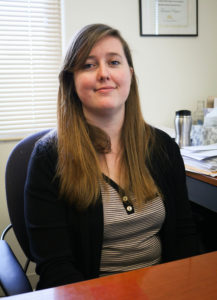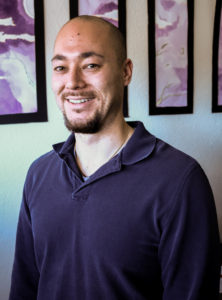Tags
Related Posts
Share This
International Resources

Tamara McCool works in the international office. Photo by Hawie Reyne Veniegas
When it comes to studying internationally, culture shock can be a difficult obstacle to overcome. From culinary differences to language barriers, international students have a lot of adjustments. Fortunately, there are resources available at the Santa Fe University of Art and Design to make this transition as smooth as possible.
The process begins with admissions, which Tamara McCool says is “pretty similar” to the domestic process. “The only additional application element is proof of English proficiency and there are a couple of tests that we use to do that,” McCool explains. Students must also apply for a Student Visa for how long they will be studying. “We issue them their I-20. The I-20 is basically a document saying they have been accepted into our institution and they’re going to be studying here so they qualify for a student visa.” Students then use that form to obtain their visa.
Film junior Arturo Larz Pallares, who arrived from Spain three weeks ago, says that while he feels supported by the school, he wishes the international office had helped him more with obtaining his visa. “It was a freaking hell,” Pallares says. The process took “weeks and weeks and weeks of asking things and information,” and was a very confusing process that he wishes the school had helped guide him through.
Once students are on campus, McCool explains that international students are absorbed into life on campus. “It’s a very immersive experience,” McCool says. They eat, live and go to classes alongside domestic students, allowing themselves to fully engage with American culture.

Arturo Larz Pallarez is an international student from Madrid, Spain studying film. Photo by Hawie Reyne Veniegas
Student Life also plays a roll in making international students feel welcome at SFUAD. Ryan Davis says Student Life is most concerned with helping international students connect with the community. The office does this by planning events at which international and domestic students can interact. “International students really want to form bonds and friendships with Americans, especially Americans who are predominantly English speaking because it really helps them with their English,” Davis says. In the future, Davis wants to bring on a Multicultural Affairs Officer to the Student Life team. “[The Multicultural Affairs Officers] would work with all underrepresented students… including international students. Their job would mainly be creating programming and providing services specifically to all of those populations,” he says. Daniel Rodriguez, a Film junior from Spain, says that the events have been helpful in making friends. “Everyone is really kind here.”
Davis says Housing also hopes to add kitchens to some of the residents halls, which they believe will help both international and domestic students. One of the biggest things that international students have difficulty with is “food shock.” South Korean student Min Kim says that was something he really struggled with transitioning to American culture almost two years ago. One of the main reasons he moved off campus was because he wanted to be able to cook food from his own country. “I was homesick, I was having a stomach ache… I couldn’t eat anything but American food. American rice and Korean rice are a little different. I desperately needed to be able to make my own food,” Min says. Other international students agree. Rodriguez told Jackalope that he eats mostly sandwiches in the Cafe because of food shock. “I think a kitchen would be very helpful,” he says. While Housing Director Timothy Chambers could not be reached to discuss the culinary addition, students hope they will soon be made available.

Hideki Nakazono is the Writing Center director. Photo by Hawie Reyne Veniegas
Another major resource for international students is the Writing Center. Writing Center Director Hideki Nakazono says that while the ratio of international to domestic students using the Writing Center is 10/20, international students make up 60 percent of the center’s repeat visitors are international students. “Some of our [employee] training revolves around working with English as second language or non-native English students,” Hideki says, although he explains that English comprehension isn’t the only issue that the Writing Center helps its students with. “We make sure that as tutors we consider, in addition to the language barrier, the awareness of a shift in culture that can be difficult to overcome. In our writing or even in our day-to-day speech, we [as Americans] tend to utilize English cultural reference that we don’t even think about because they’re so second nature for us. These sorts of things can leave students coming from other countries a little bit confused. That’s not necessarily a language barrier. It’s more of a culture barrier.” Hideki and his team of tutors are dedicated to making sure international students have a resource to ask questions about both language and cultural differences in regards to their academic work. The Writing Center opens Feb 6.
While culture shock is a difficult problem for international students to deal with, students Jackalope spoke with felt that they had enough support from the school to make their study abroad experience an easier transition.






 Jackalope Magazine is the student magazine of Santa Fe University of Art and Design. Building on the interdisciplinary nature of our education, we aim to showcase the talent of our university and character of our city.
Jackalope Magazine is the student magazine of Santa Fe University of Art and Design. Building on the interdisciplinary nature of our education, we aim to showcase the talent of our university and character of our city.
Can everyone read a reply if i leave one ?
Civil non-spam comments are approved by the site administrator and readable by all.